El árbol bonsái y el arte de crearlos nacieron de la idea del zen y la forma en que podían traer paz con solo su existencia. Los jardines de árboles bonsai son tranquilos e incluso pueden conducir a un estado de meditación que elimina el estrés y la ansiedad de un mal día. Lo que quizás no sepa es que no hay una raza específica de árbol que sea un bonsái. Sin embargo, uno de los más populares entre quienes cultivan el árbol bonsái es el árbol de lluvia brasileño.
'Bonsai' es un término japonés, y se traduce literalmente al inglés para significar 'plantado en un contenedor'. Entonces, un bonsái es cualquier árbol que se cultiva en una maceta o contenedor y se mantiene como una versión pequeña y ornamental del árbol más grande. En lugar de ser "enanos", utilizan las semillas del árbol de tamaño normal en la naturaleza y se entrenan y cultivan para imitar la apariencia en una versión miniaturizada.
Orígenes
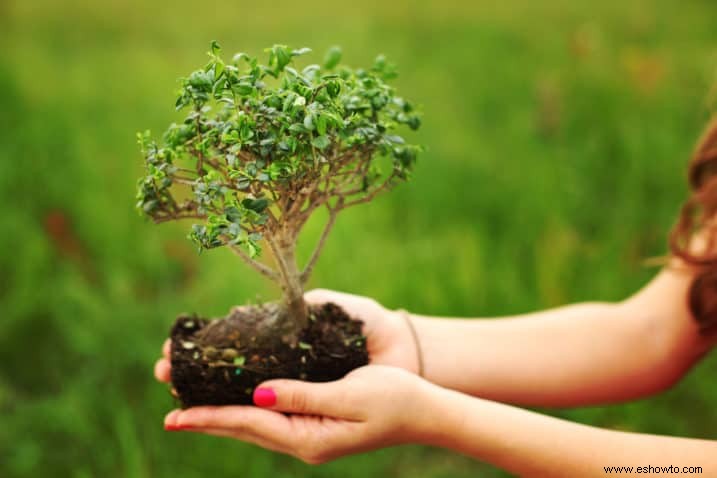
La práctica hortícola y el arte del bonsái se remontan a siglos atrás, originándose hace más de mil años en China y luego asumido por los japoneses. En la antigua China, la práctica se llamaba penjing, y fue a partir de ahí que comenzó la práctica japonesa.
Existe una gran cantidad de evidencia de que los embajadores imperiales japoneses y los estudiantes de budismo viajaron a China desde el siglo VI y, al hacerlo, encontraron fascinantes muchas cosas sobre la cultura. De hecho, a menudo regresaban con una gran cantidad de regalos y recuerdos a su país de origen. Entre sus favoritos estaban estos árboles en miniatura. Puede encontrar exhibiciones en museos que atestiguan esto, que representan las plantas talladas en plata y madera, estas obras de arte se remontan al primer uso conocido de bonsái en el budismo zen.
Conceptos básicos
Como se mencionó, los árboles que ves como bonsáis, incluidos los árboles de lluvia brasileños, no están modificados genéticamente de ninguna manera para crear una raza enana. Cuando se trata de la jardinería de bonsáis, literalmente puedes crear un árbol bonsái de forma natural a partir de cualquier árbol que encuentres en la naturaleza. Es un proceso muy detallado, pero vale la pena el esfuerzo para obtener la recompensa. Entre los entusiastas del bonsái, los bonsáis brasileños son increíblemente populares, siendo algunos de los más intrigantes en apariencia en forma de bonsái y también más fáciles de cultivar que muchas otras especies de árboles como bonsái. Quizás el mayor desafío a superar con los bonsáis brasileños es que crecen rápidamente, lo que requiere una atención más frecuente a la poda y el modelado. Sin embargo, son increíblemente atractivos y atraen a muchos jardineros.
Creación
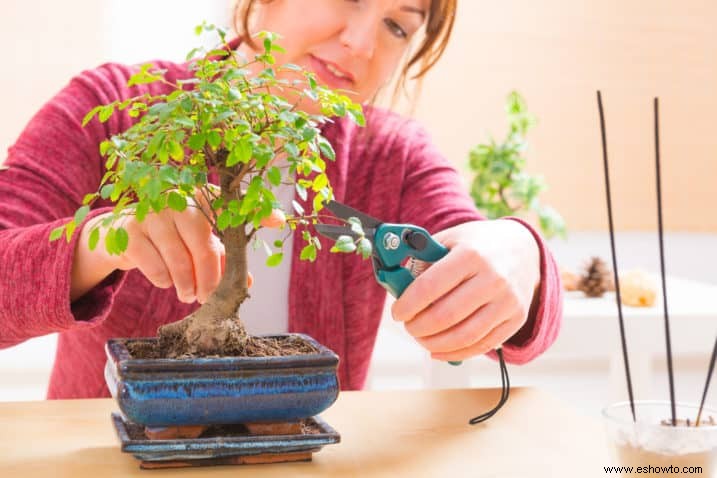
Para crear un árbol bonsái, debe tenerlo en un contenedor y debe mantenerlo podado y recortado, o seguirá creciendo a su tamaño natural. Tenga en cuenta que, a diferencia de los árboles en la naturaleza, un árbol bonsái depende completamente de usted para crecer y tomar forma. Varias técnicas entran en juego con la creación de un árbol bonsái, y con los bonsáis brasileños, tienes que estar en la cima de tu juego o te superarán rápidamente. Tendrá que podar, a veces alambre (aunque debido al patrón de crecimiento específico y la suavidad de un árbol de lluvia brasileño, debe tener especial cuidado con esta práctica), encordado y detalle para el riego y la fertilización adecuada son todos necesarios.
Historia del bonsái brasileño Rain Tree
Esta es una especie de bonsái que tiene un origen fácil de rastrear, ya que no data de mucho tiempo atrás. En la década de 1970, Jim Moody, que dirigía Jupiter Bonsai, recibió algunas semillas de su cuñada que había recolectado en Brasilia, Brasil. Jim nunca rechazó una oportunidad, las plantó e hizo que 5 germinaran. Durante 7 años, crecieron, a uno en particular le fue bien en una maceta de bonsái en cascada. Lo diseñó en posición vertical y el árbol fue reconocido a nivel nacional a través de revistas e incluso en un libro.
En su mayor parte, cualquier árbol bonsái brasileño en los Estados Unidos, y muchos en otras partes del mundo, se remontan a esa planta original cultivada por Jim Moody, ya que casi todos provienen de esquejes de ese árbol.
Tamaños para Rain Tree Bonsai
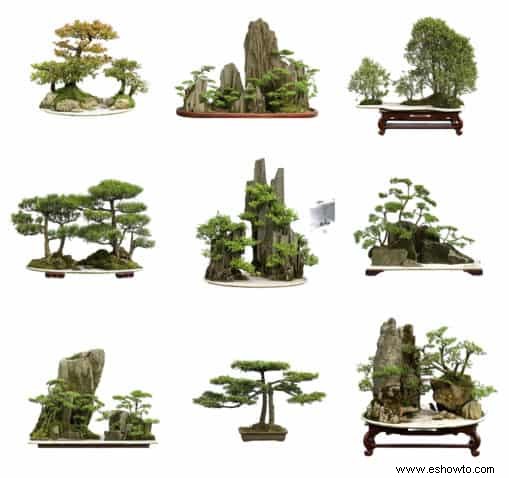
Crear árboles bonsái consiste en reflejar la naturaleza en miniatura. Entonces, un árbol bonsái debe imitar la forma y apariencia de la estética natural de su contraparte más grande. Por ejemplo, los árboles de lluvia brasileños tienden a crecer rectos o ligeramente inclinados, dependiendo del viento en el área donde crecen. Por lo tanto, los bonsáis brasileños no deben crearse con un tipo de crecimiento con curvas, de ida y vuelta.
Los árboles de bonsái más comúnmente reconocidos son bastante pequeños, pero en realidad hay varias clasificaciones de tamaño diferentes porque los árboles en miniatura en contenedores pueden crecer hasta 80 pulgadas (más de 6 pies), dependiendo de la especie que estés cultivando. Las clases más pequeñas de bonsáis son cada vez más difíciles de podar y entrenar en una forma natural, por lo que algunas especies no se equiparan bien a los bonsáis más pequeños a menos que esté buscando una interpretación más abstracta de la apariencia del árbol. Para los árboles de bonsái brasileños, el tamaño es excelente en una amplia gama de clasificaciones, aunque nuevamente, es difícil de mantener en el extremo más bajo de la escala:
- 1 a 3 pulgadas – Keshitsubo
- 2 a 4 pulgadas:Shito
- 2 a 6 pulgadas – Mame
- 5 a 8 pulgadas:Shohin
- 6 a 10 pulgadas – Komono
- 10 a 18 pulgadas – Katade-mochi
- 16 a 36 pulgadas:Chumono o Chiu
- 30 a 48 pulgadas:Omono o Dai
- 40 a 60 pulgadas – Hachi-uye
- 60 a 80 pulgadas – Imperial
Algunas de las categorías de tallas se superponen porque los sistemas de clasificación se han disputado durante el tiempo suficiente y con la frecuencia suficiente como para cuestionar dónde se traza la línea. También cambió con el tiempo, ya que el sistema original se creó para indicar la cantidad de hombres que se necesitarían para mover un árbol de ese tamaño, completo con su contenedor.
Contenedores de árboles bonsai brasileños
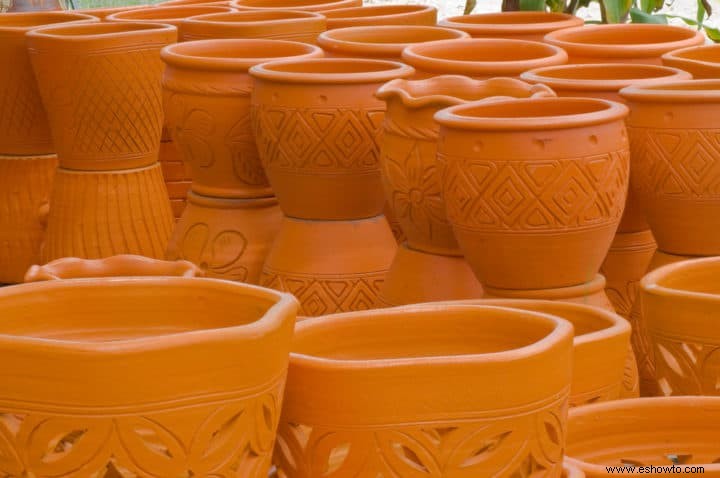
Cuando se trata de elegir un contenedor para los bonsáis brasileños, puede apegarse fácilmente a la tradición porque estos bonsáis se crean a partir de árboles que no crecen increíblemente altos desde el principio, por lo que no necesitan el sistema de raíces extensamente profundo que tienen otras especies. hacer. Por lo tanto, puede elegir una de las macetas de barro poco profundas que son distintivas de la cultura del bonsái, generalmente en tonos tierra que son sutiles y no restan valor al arte del árbol en sí.
Otra opción es ir con una maceta de jade, que a veces es una opción utilizada en la tradición japonesa, especialmente si quieres hacer crecer el árbol de la lluvia brasileña un poco más grande. La mayoría de las veces, las macetas de jade son más profundas y le ofrecen la oportunidad de convertir el árbol en una planta llorona o rastrera, con lados hacia abajo en los que puede entrenar las ramas para que se arrastren. Si bien este no es el estilo preferido para esta especie en particular, aún es posible y se ve increíble cuando se hace bien.
Distinción y compra de árboles de lluvia brasileños
Una cosa que es única sobre el árbol de lluvia brasileño es que pertenece a la familia de las leguminosas, como los guisantes y los frijoles. Son nativos de los climas tropicales de América Central y del Sur y, en la naturaleza, pueden tolerar climas cálidos y secos, como se ve en las áreas muy arenosas en las que tienden a crecer. Puede alcanzar una altura de más de 15 pies y es fácilmente uno de los árboles más bonitos entre los árboles de las regiones de la selva tropical.
El follaje del árbol de la selva tropical brasileña es de un verde intenso, y debido a que produce pequeños folíolos, los que cultivan árboles bonsái lo prefieren mucho entre las especies disponibles. Curiosamente, las hojas son muy distintivas porque se enrollan sobre sí mismas por la noche o incluso durante el día cuando está nublado y, a veces, bajo la lluvia. El clima extremadamente cálido también puede causar esta reacción.
El tronco del árbol de la lluvia brasileña también es bastante interesante, ya que crece de un color marrón oscuro natural y estriado. Sin embargo, la corteza se exfolia, y cuando se desprende, deja tiras de coloración más clara, casi blanca, suave y que contrasta mucho con la corteza. Este es un árbol espinoso, así que ten cuidado porque querrás podar las espinas.
Las flores son blancas e hinchadas y, a medida que envejecen, se vuelven de un amarillo suave. Sin embargo, este es un árbol de rápido crecimiento, por lo que la necesidad de una poda frecuente significa que es posible que no tenga mucha floración en un árbol bonsái si está controlando adecuadamente el crecimiento para determinar el tamaño.
Cuando se quitan las espinas o se desprende la corteza, el tronco del árbol a veces se retuerce, haciéndolo muy llamativo a la vista, que es otra razón por la que a los entusiastas del bonsái les encanta el árbol de lluvia brasileño como base para crear su trabajo.
Además, tenga en cuenta que, en la naturaleza, el árbol de la lluvia brasileña está catalogado como "en peligro crítico", lo que significa que puede tener dificultades para encontrar semillas naturales. Sin embargo, estos se cultivan fácilmente a partir de esquejes, y encontrará plantas iniciales en varios especialistas y en algunos viveros en todo el país y en todo el mundo debido a su popularidad general.
Creciendo
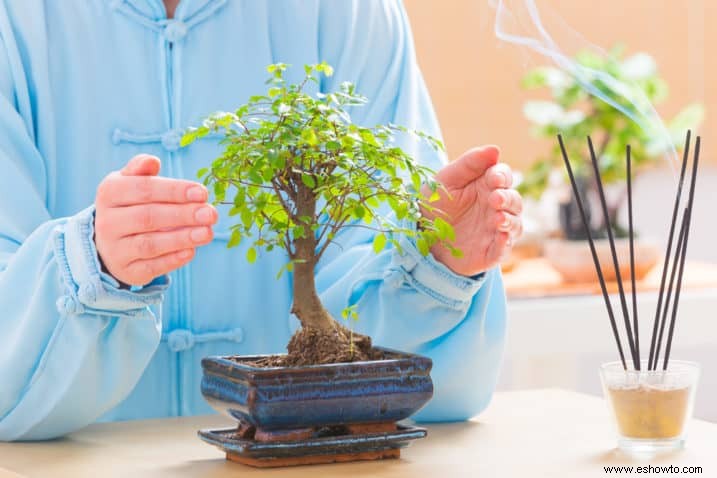
Si tiene la intención de intentar el crecimiento y la formación de un bonsái brasileño, deberá comenzar por identificar uno que esté creciendo sano pero que aún no haya alcanzado un tamaño demasiado grande. Ya debe estar podado con cuidado, ya que puede tener dificultades para mantener el tamaño y la salud si tiene que cortarlo demasiado.
Evaluar las plantas disponibles para morir. Esto significa que las ramas no se han podado correctamente y es probable que se corten demasiado cerca del tronco, o bien se han alambrado y ensartado con demasiada fuerza, lo que provocó la ruptura del sistema de alimentación interno. Si tiene muchas flores, probablemente no se haya recortado lo suficiente y será difícil de domesticar y entrenar.
Necesitarás una planta fuerte y vigorosa para comenzar tu viaje de bonsái, y eso significa que debes encontrar mucho material verde, en lugar de ramas sólidas. Si bien debe usar técnicas específicas con cautela con esta especie más suave, vale la pena tener cuidado al elegir una planta que pueda recortar en lugar de una que tenga que persuadir para cultivar material nuevo. Por lo tanto, encuentre el equilibrio entre demasiado crecimiento y falta de vegetación fresca.
Temperatura
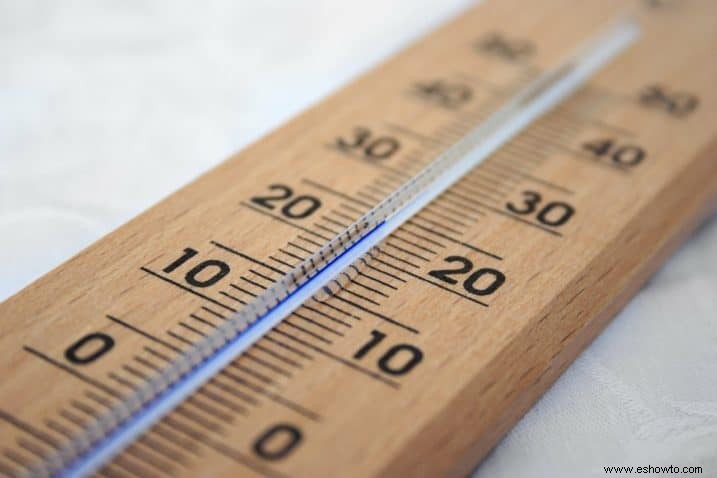
Tenga en cuenta que, a diferencia de los bonsáis de hoja perenne, el árbol de lluvia brasileño es tropical. Por lo tanto, aunque puede tolerar algunas fluctuaciones a temperaturas más bajas, se vuelve frágil con el frío. Este no es un árbol de bonsái que quieras dejar afuera durante el invierno, ya que descubrirás que podría morir mucho.
Cuando las temperaturas bajan a 45 grados Fahrenheit, es hora de ofrecer protección a su árbol. Es probable que desee llevarlo al interior, aunque deberá asegurarse de que reciba suficiente luz solar. Si no tiene una ventana donde pueda prosperar, tendrá que obtener una luz de crecimiento para que el árbol de lluvia brasileño sobreviva en el interior. Eso sí, es fundamental sacarlo del frío para el invierno.
Luz y posición
A medida que cultive sus árboles bonsái, deberá tener en cuenta que los árboles naturales se cuidan solos, pero los ha sacado de su entorno natural y los ha puesto en macetas. Por lo tanto, ese árbol depende completamente de ti para sus necesidades. En otras palabras, si bien un árbol en la naturaleza puede sobrevivir e incluso prosperar en una amplia gama de entornos, deberá proporcionar la luz adecuada y el posicionamiento adecuado para aprovechar al máximo su bonsái brasileño.
Las cosas más importantes para este tipo de bonsái son la temperatura y la iluminación. Debido a que este es un árbol tropical, debe mantener temperaturas más cálidas y moverlo al interior durante el invierno. Al mismo tiempo, encontrará que incluso este árbol abundante que está acostumbrado a las altas temperaturas no está tan emocionado con el calor del día durante el verano. Es posible que veas que las hojas se doblan durante estas horas y, en ese momento, el árbol corre el riesgo de quemarse con el sol.
Trate de ubicar su bonsái brasileño donde reciba mucha luz solar pero quizás donde pueda obtener un poco de sombra en medio del día más caluroso. Si es necesario, muévalo para que no se dañe.
Cuando lo mueva al interior durante el invierno, deberá asegurarse de que todavía reciba mucha luz. Trate de encontrar una ventana que ofrezca una gran cantidad de luz solar, aunque un poco de sol directo podría dañar las hojas y provocar la muerte. Es posible que desee optar por una luz de crecimiento, sobre la que tiene más control, para mantener la salud de su árbol bonsái.
Riego y Humedad
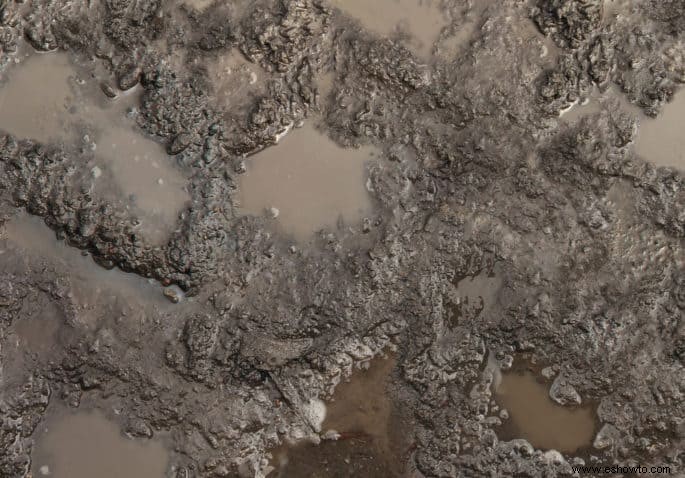
Esto puede parecer que no es importante ya que el árbol de lluvia brasileño crece salvajemente en suelo arenoso y seco. Sin embargo, cultivar un árbol bonsái requiere una atención especial, y esto es un poco diferente a lo que encontrarás en la naturaleza. Debido a las condiciones de la selva tropical en la que crece de forma natural, este árbol en particular es parcial a la humedad y, como bonsái, necesita tanto la humedad adecuada como el riego para prosperar.
Básicamente, el árbol debe mantenerse uniformemente húmedo. Tiene dos opciones para proporcionar suficiente humedad. La primera es rociar las hojas y ramas con agua diariamente, recubriéndolas ligeramente para que al día siguiente vuelvan a estar secas. The less active way to manage humidity is to have a humidity tray with pebbles, allowing your tree to draw up the humidity it needs.
In terms of keeping your Brazilian bonsai tree properly watered, you want to ensure that the soil is evenly moist when you’re done the watering and that it is dry before you water again. While bonsai require a great deal of moisture, over watering leads to poor tree health, experiences with root rot, and growth of mold and mildew that can easily weaken and even kill the tree in question.
Feeding, Fertilizing, and Soil
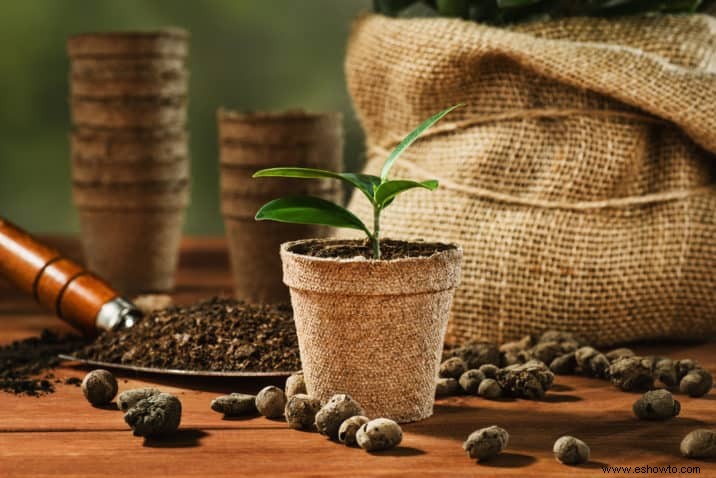
Bonsai trees grow in specialized, shallow pots, meaning they have much less soil than the average potted plant. In normal growth of potted plants, the growth is achieved because the plant can absorb adequate sustenance from the potting soil. With a bonsai tree, this isn’t possible because there just isn’t enough soil to keep it fed for long periods of time.
Liquid fertilizer is a great solution for the Brazilian bonsai tree. A weekly feeding during the growing season (spring through fall) and monthly through the winter is ideal to keep your bonsai tree strong and healthy. Take care, however, since you should use about half the recommended amount on the package of general use fertilizer when feeding your bonsai, or you could overstimulate the tree. This is especially true with fast-growing species like the Brazilian rain tree.
Another way to provide fertilizer, aside from direct soil contact, is to use a spray on the leaves and green growth. Your tree will respond quite well to a 50-50 mix of water and fertilizer sprayed evenly across its foliage.
Pruning
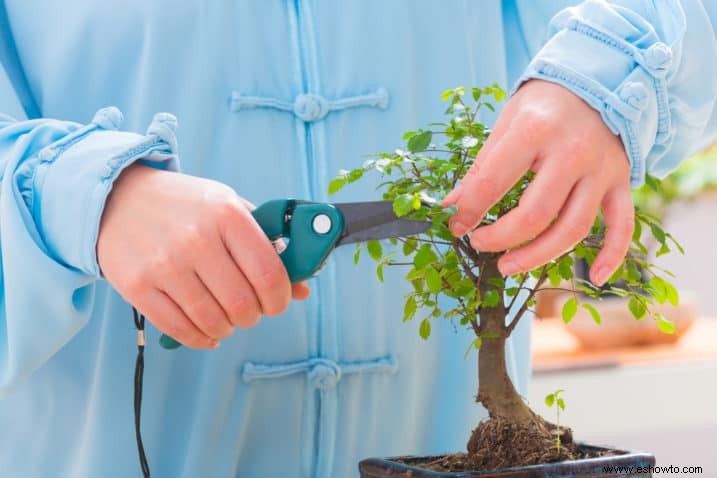
Some trees are easier to control as bonsai than others, partially dependent on the swiftness of growth. With the Brazilian bonsai tree, it’s essential to watch carefully throughout the growing season, as this is a fast-growing species and needs more care to maintain its proportion and shape like a bonsai. Also note that, when it comes to training, the constant new growth means a lot of softer, greener material, and you’ll have to take certain precautions if you want to shape it any way other than upright. Here are some tips to assure you don’t cause any issues with growth while still keeping your Brazilian bonsai tree properly pruned.
- Cut branches as needed. However, take special precautions to leave a nub. Brazilian rain trees experience dieback commonly after a trim, and you want to account for this so that the dead areas don’t reach back into the trunk.
- Stay away from concave cutters. These make it difficult to watch out for cutting back too far and can easily cause damage when die back becomes internalized rather than retained only on the branches that have been cut back.
- Keep up on new growth. Trimming the green limbs will help fill in the foliage at the top of the tree and create the twisted, striped appearance in the trunk below as it grows upright. If you come across a fully formed branch that needs to be cut, be cautious and utilize the right tool, as a mistake can damage the rest of the tree. It’s better to cut and grow with the new growth and to train softer, newer limbs than to work with the Brazilian rain tree once it’s hardened into place.
Wiring
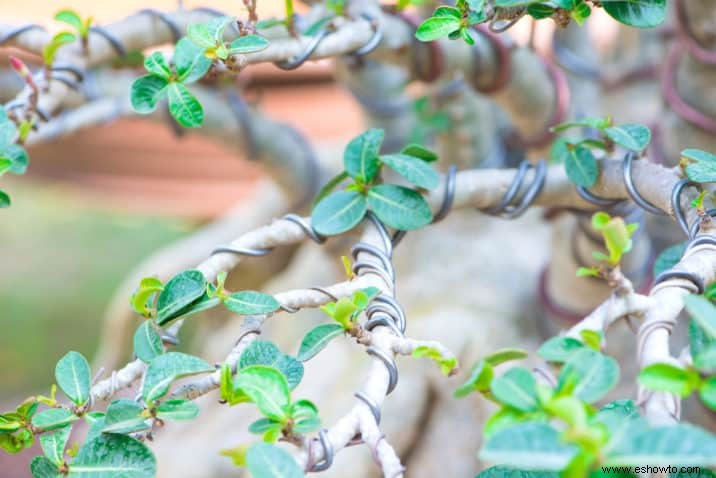
In most cases, the wiring is the process that bonsai enthusiasts use to shape bonsai trees as needed, creating the desired appearance so that it mimics nature. This common practice will hold limbs in a particular position so that the tree is forced to grow that way. For example, many trees that grow on the sides of mountains lean toward the sunlight, and in bonsai containers, you can recreate this shape using wires to force the tree to reshape and grow in a direction that looks like the natural plant.
However, with Brazilian bonsai trees, you run into a bit of an issue. First, the hardened branches are very difficult to train, which means you could have to work with them for years to get them to grow the right direction. Second, the new growth is soft and grows quickly, which means wiring is not an ideal practice. How so?
Remember how quickly these particular tree species grow. You’ll be working with green material, and using wires can literally cut into the growth and cause it to die before you can train the new branches and limbs to take shape. There are also thorns to worry about, and while you can strip these later, they can get in the way of the wire or vice versa.
Considering the hardwood is incredibly difficult to manipulate and should only be done with wiring if you need to hold a branch down for some reason, this isn’t the recommended means of training the tree, either. In fact, because the Brazilian rain tree grows upright in nature, unless affected by strong winds into a slight lean, most bonsai grown from these seeds or cuttings are maintained upright and mostly manipulated through cut and grow procedures.
If you are going to train your Brazilian bonsai tree to grow a certain direction, it’s recommended that you use nylon strips that won’t damage new growth and will allow for thorns to grow without hindrance. This material is also strong enough to manipulate the new greenery, which is so much softer than the hardwood branches that develop over time.
Propagation
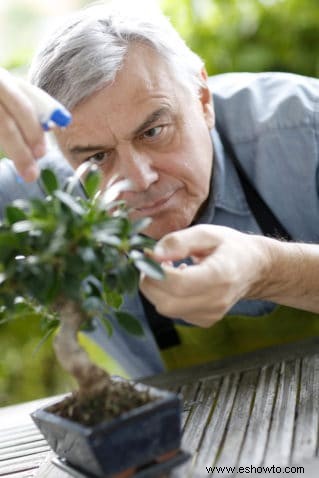
While Brazilian bonsai trees can be propagated from either seeds or cuttings, the fact that the species is endangered means that seeds could be hard to come by, especially since frequent trimming to control growth and size of bonsai means a lack of blooms and seeding. Cuttings from air layering techniques are the most common way to propagate a new bonsai.
Keep in mind that cuttings should only be taken from this particular species during the heart of the growing season. It’s best to start assessing the possibility as the nights grow warm in late spring and take the cutting as spring transitions into summer.
Start by identifying a particularly strong, health branch. This should not be new growth but should be hardwood with bark. When you’ve identified the limb you want to take a cutting from, you’ll create your ‘air layer’. Carefully remove a ring of bark from the limb, far enough away from the trunk that you don’t risk any die back. This ring should be narrow, perhaps ¼ inch. Leave a small end of the ring intact because you’ll need the branch to remain connected to the rest of the tree if it’s going to survive.
Once this is complete, you’ll need a small plastic bag, peat, sphagnum, and water. Inside the bag, make sure you have a good mix of the peat and sphagnum, and then make sure it’s plenty moist. Then, you’re going to wrap the bag around the cut area, and you need to seal it in a way that the moisture can get into the tree without making it so you can’t add water on a regular basis to keep the mixture uniformly moist.
This isn’t a fast project, and it’s going to take anywhere from 6 to 12 weeks to see roots start to form. They’ll form around the base of the upper portion of the branch, above the ring you cut, and create a root ball. When there are enough roots to support the cutting, you can cut the limb off just below the root ball.
Once you’ve taken the cutting, wrap the bag of mixture around the roots and find an appropriately sized bonsai container for planting. Make sure the root system is supported, and watch the new propagation carefully over the next few weeks to assure it’s developing and doesn’t have any issues going forward. You should quickly and easily discern the success of your attempt. Remember to feed and water regularly, just as with any bonsai, so that your new Brazilian rain tree is healthy and strong.
Repotting
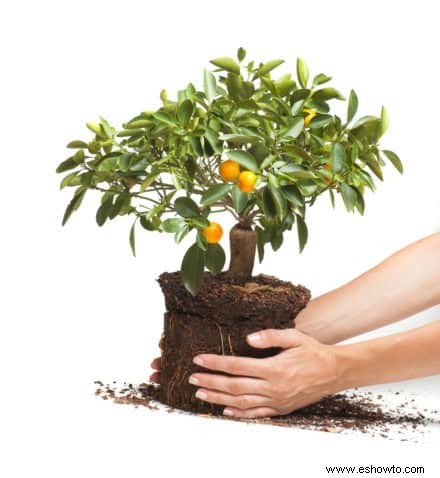
Brazilian rain trees are fast to grow, so you’ll need to monitor them carefully for the right amount of space in the container for the root system. Note that, if the roots become pot bound, your tree will likely start to ail in terms of growth and lush foliage. Interestingly enough, despite their quick growth, the root system doesn’t seem to match the intensity of the branches and leaves, growing more slowly.
In general, it’s a good idea to repot your Brazilian bonsai tree every 2 years, though, in some circumstances, you’ll only need to do so every 3 years. Just assess the growth of the roots from time to time, checking under the soil, to get a good idea of when you’ll need to take action.
Timing is of the essence if you are going to repot your Brazilian bonsai tree, just like the rest of the process of caring for your tree. Take into account that, as with most practices, anything that involves active growing should be accomplished during the growing season. You’ll find that you get the best results if you repot during mid-summer.
Styling
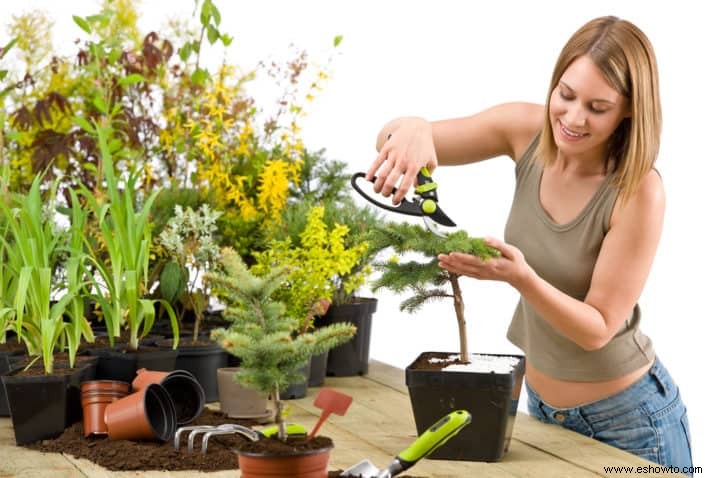
A lot of bonsai trees require extensive styling to create the proper appearance, and others are styled to a specific look that may not create a mirror image of its design in nature but is very aesthetically pleasing. However, when it comes to the Brazilian bonsai tree, the tree is typically allowed to grow upright, with little need for other training. That’s because it grows upright in nature and looks amazing with just the usual trimming and growth allowed. Perhaps the most ‘stylized’ effort for this species of a bonsai tree is the cutting back of branches to create the twists that occur in the trunk when branches are removed.
However, every gardener likes a challenge, and because the Brazilian rain tree grows so quickly, it can certainly present a challenge to style it in one of the traditional designs, or even in a more abstract way that doesn’t have anything to do with its natural upright growth. Here are a few styles you could try with the Brazilian rain tree if you have a good eye and a good grasp on the concept.
- Shakan bonsai – If you like the look of a tree that leans with the pressure of wind or toward the sun from the side of a mountain, you’re probably partial to this style. It’s used often with evergreens but not as frequently with tropical trees. However, you could adjust the angle at which the tree grows, if you choose particular branches to trim, creating a 60 to 80-degree angle from the ground, or pot. Be aware that this can take years to achieve and you’ll need extreme patience to do it with the Brazilian bonsai tree
- Dramatic Fukinagashi – You might find the Brazilian rain tree looking this way in nature if it’s growing in a coastal region with frequent strong wind gusts. This style looks very much the way trees do when they are constantly windswept in a certain direction, with all limbs on one side of the trunk. Because the Brazilian bonsai tree calls for continuous maintenance anyway, you can trim all the branches from one side (not too far back, with the ability to remove the dead nubs later) and only maintain growth on the other side of your tree. However, unlike some species, this tree will likely never adjust and stop growing on all sides, meaning you’ll be working on the shape throughout its life.
- Shari bonsai – While the style is intended to look similar to trees that are grown in harsh environments, it also lends itself well to Brazilian bonsai trees. That’s because these trees already shed bark, so stripping additional bark and limbs to keep the lower part of the usually upright tree isn’t a difficult task if you keep up with the fast growth of these bonsais. In the end, you’ll have branches and foliage mainly at the very top of the tree, which can be quite attractive for this species.
- Seki-joju/rocky terrain – This particular style has more to do with showcasing the versatility and adaptability of the roots of the tree than shaping the tree to appear natural or abstract, and it can be used with almost any species, including the Brazilian bonsai tree. The roots are made to grow over and around natural obstacles, such as large stones within the shallow container, for an artistic and pleasant appearance.
- Han-kengai – Perhaps one of the hardest styles to achieve with a Brazilian rain tree, this is a ‘cascading’ style of bonsai. The idea is to keep the trunk of the tree very short and grow straight upward – this part goes along with the way this species grows if you maintain the stunted height. However, you’ll have to work hard to train the new greenery to grow downward, in a ‘weeping’ fashion, since this is highly unnatural for the species. If you can accomplish the task, it’s a gorgeous way to grow the Brazilian bonsai tree.
As mentioned, you don’t have to train this species into any particular style. In fact, they tend to style themselves into a natural appearance, aided in maintaining the miniature version of bonsai with care through pruning and trimming.
Pests and Disease
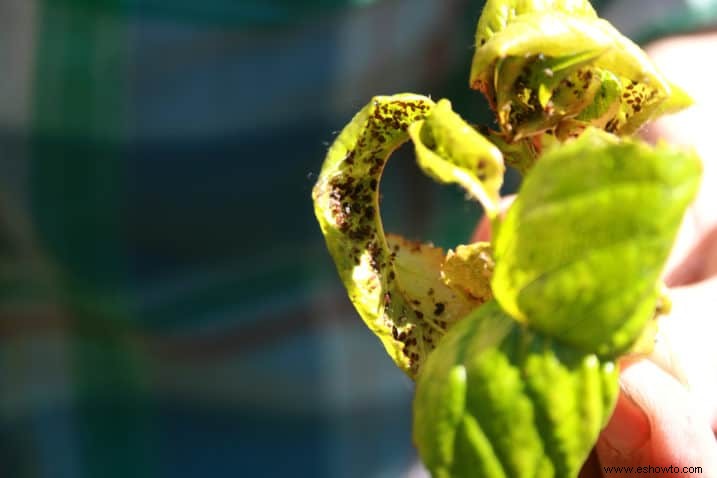
As a gardener, you’ll need to know what to expect with any plant you maintain when it comes to potential threats from pests or disease. The same is true for all bonsais, including the Brazilian rain tree. While you’ll find that few insects and pests are attracted to the tree, there are a few particular greenhouse pests that are common, and others that can be a problem if you keep the tree as an indoor plant.
Nematodes are particularly detrimental to the roots of the Brazilian bonsai tree, creating visible nodules that can harm the growth and ability to get nutrients from soil or fertilizer. Use a nematode-specific pesticide for best results. Indoors, you may experience difficulty with spider mites, aphids, or whiteflies. You can also use specific pesticides for these. However, to go the organic route, mix equal parts water and vinegar, and spritz these bugs away, on a daily basis, until they are gone.
If you are careful with the way you water and feed your Brazilian bonsai tree, you likely won’t experience any problems with diseases. This species isn’t prone to any particular problems but can suffer from root rot, mold, and mildew if overwatered.
Conclusión
The art of bonsai can be very satisfying, but it’s by no means a simple task. If you’re a novice, you might want to start with something that is easy to train and doesn’t require much pruning so you can grow accustomed to the process. The Brazilian bonsai tree meets about half that requirement, though as a fast-growing species, could be difficult if you’re new to the process. Remember, you can use any species to start creating bonsai trees, as the term refers to the dwarfing of the natural tree through pruning and shaping rather than referencing a particular species.
As you gain confidence in your ability to maintain the appropriate shape and size of the bonsai species you choose, it’s much easier to branch out into other species, such as the Brazilian rain tree. As time allows, you may become interested in working on a complete display of bonsai trees. In fact, people adore bonsai gardens, finding peace and joy wandering through the artistic designs and the spectacularly maintained trees. Continue working your bonsai trees with appropriate blooms and landscaping, as well as some hardscape designs that mirror the types of containers you’re using so everything blends naturally.
Don’t forget that your Brazilian bonsai trees will need room indoors to make it through harsh winters (something you may not have to worry about, depending on your climate). You’ll also want to make sure they get plenty of sunlight at all times, which means you may need indoor grow lights. And unless you need your tree’s trunk to thicken, you shouldn’t plant it directly into the ground at any point in time, or it could easily grow out of control.
All you need is an open mind, some spare time, and a passion for growth and art to get started, and you can have your own little peaceful haven of bonsai trees growing around you.

